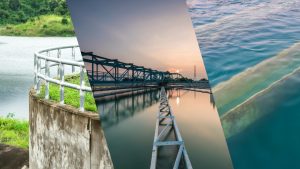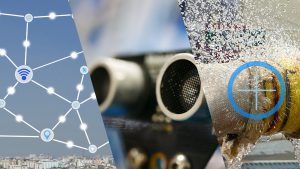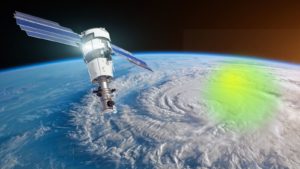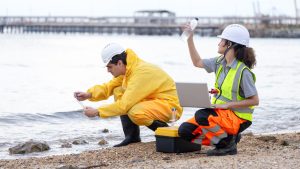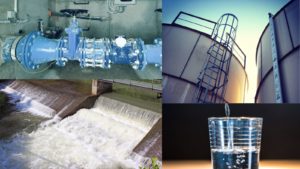Worldwide, various industries, including the water industry, have undergone digital transformations as a result of the Fourth Industrial Revolution (FIR), also known as Industry 4.0. In the modern world, the majority of the water sectors are switching from conventional water solutions to smart water management systems that use Big Data and cutting-edge analytics to offer different insights that will enhance water management, water quality, and operational efficiencies. Many nations throughout the world, such as Australia, are currently dealing with a variety of water challenges; hence it is necessary to embrace the new, cutting-edge technologies of Industry 4.0 to help the water sector enhance, manage, and distribute the water utilising 21st century “smart technologies.” The water industry has been deemed to benefit from modern Industry 4.0 technologies, and digital technologies are reshaping the industry. Industry 4.0 houses technologies classed in pillars with competent capabilities to reform the water industry. Read on to discover how the pillars of industry 4.0 will optimise Australia’s water future.
4 Mian Pillars of Industry 4.0: A Way to the Future
Autonomous Robots: A Paradigm Shift
Robots are becoming more sophisticated, and as technology advances, more businesses discover applications for them. There is no exception in the water sector. Here are 5 ways that advances in robotics are supporting this.
Enhancing Leak-Detection Techniques
Leaks have a significant role in the issue of water scarcity in Australia. An autonomous robot can navigate a pipe’s interior. Its sensors pick up changes in force brought on by water leaking out as a result of a leak. Additionally, it can pinpoint a leak’s location to within a few feet. That is significantly superior to present techniques, which frequently call for water company staff to dig up sizable portions of roadways to identify the problem.
Clean Drinking Water Tanks
It takes a lot of time to keep the tanks where drinking water is stored clean. The two main methods used nowadays are draining the tanks or hiring divers to conduct the work. Its fleet of robots is entirely oil-free or only uses trace amounts of food-grade oil. The cleaning is handled by the robots, who do not disturb the water supply in any way.
Operational Improvements at Water Treatment Facilities
Closed-loop systems are frequently used in a variety of facilities, from hospitals to nuclear power plants, to treat their water needs. The benefits of this strategy include improved effectiveness and fewer chances of pollutant exposure. Some businesses are looking at using robots to assist with water treatment as well. It is possible to rely on robots to aid with some jobs that involve heavy lifting or to maintain the exterior regions of wastewater treatment facilities. Some plant inspections may also be handled by drones.
Detect Water Pollution
Robots might make it simpler to spot dangerous water contamination. An autonomous robot equipped with both artificial and biological sensors may check the water for particular pollutants and determine its toxicity without disturbing aquatic life. Additionally, the robot can modify the sensors to search for certain types of pollutants, making drinking water as safe as possible.
Reduce Unnecessary Pipe Replacement Projects
Currently, the majority of parties in the sector replace water pipes using an incredibly ineffective system. Only pipes that are beyond repair are routinely replaced, which amounts to around 5% of the network each year. That implies that replacing the entire network would take centuries. To determine which pipes in a city or municipality are most likely to need replacement, solutions can use algorithms and robotics.
Meet the New Virtual Reality with Simulation
A virtual representation of a real item, procedure, or system is called a digital twin. To create a digital twin of a water system, city-scale reality models, GIS data, and virtual engineering models must all be combined. A real-time model that may be used in operations is also produced by digital twins, which are continuously updated with virtual operational data from SCADA systems, sensors, metres, and other measurable sources. An intelligent and interconnected digital infrastructure model that facilitates smart water network planning, design, construction, and operation is the end product. Here are a few ways in which the digital twin technology can optimise Australia’s water industry:
Accurate Data
Throughout the lifecycle of a water system, from long-term system vulnerability and capacity planning to immediate performance monitoring and emergency response, digital twins of water systems provide accurate and reliable data that utilities can use to perform what-if analyses and make informed decisions. Additionally, utilities are using digital twins to simulate and test various ways that their water system could be operated to improve emergency response, increase efficiency, or save energy because integrating SCADA data and hydraulic models can provide an accurate assessment of how the current water system behaves. To assist risk-based strategic lifecycle asset management, digital twins can make use of data from already-existing work management and asset management systems as well as other corporate systems. These benefits help utilities optimise lifecycle costs, extend the useful life of assets, and prioritise capital improvement projects.
Foreseeing the Future
Utility personnel can visualise an asset (in the context of the system and the environment), check its status, and run simulations and analyses using digital twins. In addition to assisting them in forecasting future performance and simulating the effects of potential modifications in the virtual world before funds are committed, this enables utilities to more thoroughly understand the history and present performance of their water systems. With the use of digital twins, utilities can predict performance and spot problems before they occur. For planning and design purposes, the majority of water utilities already have a hydraulic model of their system. Digital twins enable utilities to identify characteristics of their water systems, such as water age or velocity, that cannot be detected directly. This gives them a complete image of the system, enhancing physical safety and lowering pipeline breaks.
Asset Performance Optimisation
The performance of assets and risk-based planning and emergency readiness is optimised by digital twins. Digital twins produce insights that assist utilities in predicting and optimising the present and future performance of their assets and water system. They do this by utilising data more effectively and making better use of the enormous volumes of data they presently collect. Digital twins give utilities the ability to simulate incidents like pipe failure, power outages, fires, and contamination by including a hydraulic/water quality model of the system that accurately depicts the current conditions. As a result, the model aids utilities in risk assessment and system resilience analysis.
Industry of Things: Monitoring and More
The Industry of Things (IoT) can assist the water sector by providing utilities and customers with updated data on water usage. IoT can offer information regarding water consumption, quality, points of loss or leakage, distribution, and wastewater through the use of sensors. Here are the top 5 ways in which IoT can enhance water asset performance in Australia:
Level Monitoring
IoT-based level monitoring in the water sector ensures that there is enough water to meet demand. By utilising smart water management technology, you may streamline administrative duties and achieve successful results. It is completely equipped with sensor capabilities, cutting-edge analytics, a prediction-based algorithm, and other clever techniques, which make up the solution’s efficient operation and increase productivity. IoT is a revolutionary technology that aims to achieve results by utilising resources efficiently and at a low cost.
Sensor-Enabled Solutions
By using sensor-enabled solutions, the water sector may conserve water more effectively by integrating IoT. As a result of the IoT technology’s numerous uses across a wide range of industries, industrialists are already accepting it. The utility sector is successfully offering end-to-end services to its clients owing to the deployment of sensor devices and other cutting-edge technologies. As a result, it boosts their output while also giving them better benefits. IoT is a sensor-based technology; therefore, these devices are mounted on assets and extract pertinent data for continuous plant monitoring.
Wastewater Treatment
The water sector is maximising the use of IoT principles and cutting-edge methods. By using intelligent technologies like level monitoring for real-time level measurement of the water quantity, the wastewater treatment system is being developed. Additionally, it aids in establishing a predetermined threshold value at which the user’s linked smart device would receive immediate alerts from the solution. Thus, the technique aids in efficient wastewater treatment by maximising water efficiency and minimising excessive water loss from leaks or unnoticed spills.
Intelligent Irrigation System
The amount of water utilised for irrigation is a major factor in the farming industry. Nowadays, farmers can easily irrigate their fields without wasting superfluous water owing to the adoption of sensor-enabled water metres and sprinklers. By incorporating intelligent concepts and cutting-edge methods for meeting the fields’ appropriate water requirements, IoT concepts provide intelligent irrigation systems to the agricultural industry. The farmers can specify a particular value above which the sprinkler automatically turns off using the IoT-powered sprinklers or water metres. This helps them save time and effort and ensures that the fields are remotely monitored using cell phones and dashboards.
Smart Water Meters
Water use is cited as the main source of survival and economic output by basic utilities. The majority of industries use water in significant quantities, which calls for an enhanced monitoring system that maintains tabs on all water-related activities and tracks consumption patterns. The industries are relying on improved sources and encompassing a large economic value with the aid of IoT-powered smart water metres, which results in expanded potential. The application of IoT technology in the water sector creates a competitive advantage that allows a water firm to compete and create better services to draw clients. The use of smart metres in various zones demonstrates a well-organised water management system that encourages water conservation at all costs.
Big Data: A Trendsetter in Data Collection and More
Big data is defined as data that cannot be captured, stored, or analysed using conventional means. The data is frequently gathered at such a high rate and volume that it can’t be analysed in the same manner as a less frequently updated or static data source, such as when a network of sensors pulls real-time data regarding nitrate concentration. Big data can reveal much finer detail and insights that you wouldn’t be able to obtain with normal techniques of data collecting and analysis, but it also requires specialised tools to capture and evaluate. The water industry benefits greatly from big data in the following 3 ways.
Accurate Data Collection
The water sector may gain a lot from improved data gathering and application. In addition to using a lot of resources, water treatment plants sometimes contend with old or challenging-to-maintain equipment that must work in severe environments. Both can benefit from big data. Better data enables water treatment facilities to efficiently regulate water properties like pH while purifying water with fewer chemical additives. Plants that can employ less of these compounds can slow or stop the deterioration of vital water-purifying machinery. Big data can be utilised to conserve resources as well. This can entail keeping an eye on specific indicators of water quality to determine when a filter needs to be changed. It is feasible to develop forecasting models that produce more precise and insightful forecasts by expanding the data sets that are accessible and establishing correlations between different data sets.
Predictive Maintainance
One application of big data that is becoming more common in the water industry is predictive maintenance strategies. IoT sensors attached to essential equipment track information like operating temperature, timing and vibration. Big data analytics is then used to find correlations in that data and predict when a machine is likely to fail and needs maintenance or is operating in a range that may cause excessive wear and tear. Predictive maintenance strategies can leverage real-time operational data to predict when a machine or piece of equipment will need maintenance. With the advanced notice that these strategies can provide, businesses can avoid costly downtime or machine failure. Other predictive models enabled by big data also provide significant benefits. With a predictive maintenance strategy in place, it’s possible to extend the lifespan of equipment, make maintenance schedules more efficient and prevent costly downtime by giving site staff advanced notice of potential equipment failure. Some advanced predictive systems can even automatically shut down equipment that may be on the verge of failure, possibly preventing damage to the machine.
Pattern-Detection
Big data can also integrate internal data with information from outside sources to boost the accuracy of a company’s forecasting models and projections. By combining all data into a single master set, advanced analysis is possible that can identify patterns and forecast inlet flow rates, enabling plant operators to make better operational choices. Big data may soon be able to assist operators in automating crucial plant tasks, even though the technology is not quite there yet. Future big data systems may frequently make decisions on their own based on unforeseen occurrences like flooding that can happen beyond typical business hours.
Take the Lead with Industry 4.0
The old water management system is already changing as a result of these innovations, opening up new prospects for Australian water utility providers. In the future, as the rise of Industry 4.0 continues and data collection solutions become more widespread, Australian water companies will have even more options for collecting and analysing large amounts of data. As a result, the technology may become even more valuable to the industry over time. It is even more necessary to deploy solutions that enhance integrated water cycle management in the water industry. Any Australian business in the industry has as a top priority to conserve this limited resource. Industry 4.0 can deal with specific solutions that enable more sustainable operations, such as optimising pressures in the networks, analysing the best efficiency point of pumps, lowering equipment maintenance time, minimising real and apparent losses, analysing energy usage, etc. Take control of your operations today.

